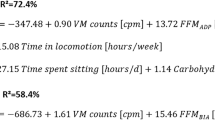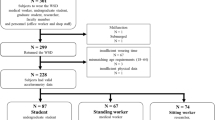Abstract
OBJECTIVE: To describe a method to obtain a profile of the duration and intensity (speed) of walking periods over 24 hours in women under free-living conditions.
DESIGN: A new method based on accelerometry was designed for analyzing walking activity. In order to take into account inter-individual variability of acceleration, an individual calibration process was used. Different experiments were performed to highlight the variability of acceleration vs walking speed relationship, to analyze the speed prediction accuracy of the method, and to test the assessment of walking distance and duration over 24-h.
SUBJECTS: Twenty-eight women were studied (mean±s.d.) age: 39.3±8.9 y; body mass: 79.7±11.1 kg; body height: 162.9±5.4 cm; and body mass index (BMI) 30.0±3.8 kg/m2.
RESULTS: Accelerometer output was significantly correlated with speed during treadmill walking (r=0.95, P<0.01), and short unconstrained walks (r=0.86, P<0.01), although with a large inter-individual variation of the regression parameters. By using individual calibration, it was possible to predict walking speed on a standard urban circuit (predicted vs measured r=0.93, P<0.01, s.e.e.=0.51 km/h). In the free-living experiment, women spent on average 79.9±36.0 (range: 31.7–168.2) min/day in displacement activities, from which discontinuous short walking activities represented about 2/3 and continuous ones 1/3. Total walking distance averaged 2.1±1.2 (range: 0.4–4.7) km/day. It was performed at an average speed of 5.0±0.5 (range: 4.1–6.0) km/h.
CONCLUSION: An accelerometer measuring the anteroposterior acceleration of the body can estimate walking speed together with the pattern, intensity and duration of daily walking activity.
This is a preview of subscription content, access via your institution
Access options
Subscribe to this journal
Receive 12 print issues and online access
$259.00 per year
only $21.58 per issue
Buy this article
- Purchase on Springer Link
- Instant access to full article PDF
Prices may be subject to local taxes which are calculated during checkout





Similar content being viewed by others
References
Grundy SM, Blackburn G, Higgins M, Lauer R, Perri MG, Ryan D . Physical activity in the prevention and treatment of obesity and its comorbidities: evidence report of independent panel to assess the role of physical activity in the treatment of obesity and its comorbidities Med Sci Sports Exerc 1999 31: 1493–1500.
Epstein LH, Coleman KJ, Myers MD . Exercise in treating obesity in children and adolescents Med Sci Sports Exerc 1996 28: 428–435.
Pate RR, Pratt M, Blair SN, Haskell WL, Macera CA, Bouchard C, Buchner D, Ettinger W, Heath GW, King AC, Kriska A, Leon A, Marcus BH, Morris J, Paffenbarger RS, Patrick K, Pollock ML, Rippe JM, Sallis J, Wilmore JH . Physical activity and public health: a recommendation from the Centers for Disease Control and Prevention and the American College of Sports Medicine JAMA 1995 273: 402–407.
Esparza J, Fox C, Harper IT, Bennett PH, Schulz LO, Valencia ME, Ravussin E . Daily energy expenditure in Mexican and USA Pima indians: low physical activity as a possible cause of obesity Int J Obes Relat Metab Disord 2000 24: 55–59.
Hakim AA, Petrovitch H, Burchfiel CM, Ross GW, Rodriguez BL, White LR, Yano K, Curb JD, Abbott RD . Effects of walking on mortality among nonsmoking retired men New Engl J Med 1998 338: 94–99.
Blair SN, Kohl HW, Gordon NF, Paffenbarger RS Jr . How much physical activity is good for health? Ann Rev Public Health 1992 13: 99–126.
Bratteby LE, Sandhagen B, Lotborn M, Samuelson G . Daily energy expenditure and physical activity assessed by an activity diary in 374 randomly selected 15-year-old adolescents Eur J Clin Nutr 1997 51: 592–600.
Almeras N, Mimeault N, Serresse O, Boulay MR, Tremblay A . Non-exercise daily energy expenditure and physical activity pattern in male endurance athletes Eur J Appl Physiol 1991 63: 184–187.
Levine JA, Schleusner SJ, Jensen MD . Energy expenditure of nonexercise activity Am J Clin Nutr 2000 72: 1451–1454.
Pols MA, Peeters PH, Kemper HC, Grobbee DE . Methodological aspects of physical activity assessment in epidemiological studies Eur J Epidemiol 1998 14: 63–70.
Wareham NJ, Rennie KL . The assessment of physical activity in individual and populations: why try to be more precise about how physical activity is assessed? Int J Obes Relat Metab Disord 1998 22 Suppl 2: S30–S38.
Schutz Y, Weinsier RL, Hunter GR . Assessment of free-living physical activity in humans: an overview of currently available and proposed new measures Obes Res 2001 9: 368–379.
Schutz Y, Deurenberg P . Energy metabolism: overview of recent methods used in human studies Ann Nutr Metab 1996 40: 183–193.
Montoye HJ, Washburn R, Servais S, Ertl A, Webster JG, Nagle FJ . Estimation of energy expenditure by a portable accelerometer Med Sci Sports Exerc 1983 15: 403–407.
Meijer GA, Westerterp KR, Koper H, ten Hoor F . Assessment of energy expenditure by recording heart rate and body acceleration Med Sci Sports Exerc 1989 21: 343–347.
Bouten CV, Koekkoek KT, Verduin M, Kodde R, Janssen JD . A triaxial accelerometer and portable data processing unit for the assessment of daily physical activity IEEE Trans Biomed Eng 1997 44: 136–147.
Eston RG, Rowlands AV, Ingledew DK . Validity of heart rate, pedometry, and accelerometry for predicting the energy cost of children's activities J Appl Physiol 1998 84: 362–371.
Chen KY, Sun M . Improving energy expenditure estimation by using a triaxial accelerometer J Appl Physiol 1997 83: 2112–2122.
Haymes EM, Byrnes WC . Walking and running energy expenditure estimated by Caltrac and indirect calorimetry Med Sci Sports Exerc 1993 25: 1365–1369.
Terrier P, Aminian K, Schutz Y . Can accelerometry accurately predict the energy cost of uphill/downhill walking? Ergonomics 2001 44: 48–62.
Perrin O, Terrier P, Ladetto Q, Merminod B, Schutz Y . Improvement of walking speed prediction by accelerometry and altimetry, validated by satellite positioning Med Biol Eng Comput 2000 38: 164–168.
Herren R, Sparti A, Aminian K, Schutz Y . The prediction of speed and incline in outdoor running in humans using accelerometry Med Sci Sports Exerc 1999 31: 1053–1059.
Antonsson EK, Mann RW . The frequency content of gait J Biomech 1985 18: 39–47.
Moe-Nilssen R . Test-retest reliability of trunk accelerometry during standing and walking Arch Phys Med Rehabil 1998 79: 1377–1385.
Bassett DR Jr, Cureton AL, Ainsworth BE . Measurement of daily walking distance-questionnaire versus pedometer Med Sci Sports Exerc 2000 32: 1018–1023.
Ainsworth BE, Irwin ML, Addy CL, Whitt MC, Stolarczyk LM . Moderate physical activity patterns of minority women: the Cross-Cultural Activity Participation Study J Womens Health Gend Based Med 1999 8: 805–813.
Melanson EL Jr, Freedson PS . Validity of the Computer Science and Applications, Inc. (CSA) activity monitor Med Sci Sports Exerc 1995 27: 934–940.
Pearce ME, Cunningham DA, Donner AP, Rechnitzer PA, Fullerton GM, Howard JH . Energy cost of treadmill and floor walking at self-selected paces Eur J Appl Physiol Occup Physiol 1983 52: 115–119.
Blessey RL, Hislop HJ, Waters RL, Antonelli D . Metabolic energy cost of unrestrained walking Phys Ther 1976 56: 1019–1024.
Mattsson E, Larsson UE, Rossner S . Is walking for exercise too exhausting for obese women? Int J Obes Relat Metab Disord 1997 21: 380–386.
Leermakers EA, Dunn AL, Blair SN . Exercise management of obesity Med Clin North Am 2000 84: 419–440.
Rippe JM, Hess S . The role of physical activity in the prevention and management of obesity J Am Diet Assoc 1998 98 10 Suppl 2: S31–S38.
Doucet E, Imbeault P, Almeras N, Tremblay A . Physical activity and low-fat diet: is it enough to maintain weight stability in the reduced-obese individual following weight loss by drug therapy and energy restriction? Obes Res 1999 7: 323–333.
Schoeller DA, Shay K, Kushner RF . How much physical activity is needed to minimize weight gain in previously obese women? Am J Clin Nutr 1997 66: 551–556.
Acknowledgements
The authors would like to thank Dominique Bécard for her help in the treadmill experiment, Kamiar Aminian for technical advice and Roland Weinsier for reading the manuscript. The study was partially supported by a grant from the Swiss National Science Research Foundation (Grant 3200-055928.98/1). The SCAM device described in this article will not be produced commercially and therefore the authors have no financial interest in the product.
Author information
Authors and Affiliations
Corresponding author
Rights and permissions
About this article
Cite this article
Schutz, Y., Weinsier, S., Terrier, P. et al. A new accelerometric method to assess the daily walking practice. Int J Obes 26, 111–118 (2002). https://doi.org/10.1038/sj.ijo.0801856
Received:
Revised:
Accepted:
Published:
Issue Date:
DOI: https://doi.org/10.1038/sj.ijo.0801856
Keywords
This article is cited by
-
Influencing walking behavior can increase the physical activity of patients with chronic pain hospitalized for multidisciplinary rehabilitation: an observational study
BMC Musculoskeletal Disorders (2019)
-
Quantification of whole-body and segmental skeletal muscle mass using phase-sensitive 8-electrode medical bioelectrical impedance devices
European Journal of Clinical Nutrition (2017)
-
Circuit training for bone health: efficacy of the bone-based rotation exercises principle
Sport Sciences for Health (2017)
-
Post-Menopausal Obesity and Metabolic Syndrome: An Analysis of Biomarkers
Proceedings of the National Academy of Sciences, India Section B: Biological Sciences (2017)
-
Bone density and body composition in newly licenced professional jockeys
Osteoporosis International (2017)



